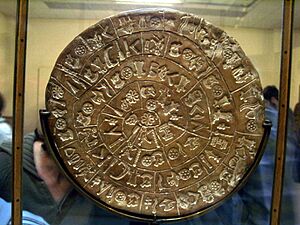Cretan hieroglyphs facts for kids
The Cretan hieroglyphs are an ancient writing system. People on the island of Crete used them a very long time ago, from about 2000 BC to 1500 BC. We cannot read them today because they are still a mystery, or undeciphered. For most of the time they were used, another writing system called Linear A was also used alongside them.
Most of the symbols in Cretan hieroglyphs look like pictures, which are called pictograms. Some symbols are still a puzzle, and experts don't agree on what they mean. Most of the writing we have found is very short. It is usually on seal stones or small clay tablets. These short writings are often just markers or labels.
There are three special items that are different from the rest. These are a stone called the Malia altar stone, the famous Phaistos Disc, and the Arkalochori Axe. We don't know exactly how these items are connected to the other Cretan hieroglyph writings.
Understanding Cretan Hieroglyphs
There are 137 different symbols in total. About 96 of these symbols seem to be whole words or parts of words. Another 32 symbols are probably Logograms. Logograms are symbols that stand for a whole word or idea. For example, a picture of a sun might mean "sun."
Numbers and Special Symbols
Nine symbols seem to represent fractions, like half or a quarter. There are also four special symbols for numbers. These symbols stand for 1, 10, 100, and 1000.
One symbol looks like a hyphen and is used to separate words. Another symbol looks like a cross. This cross probably marks the very beginning of a text. Experts believe that this writing system is probably syllabic. This means each symbol stands for a whole sound, like "ba" or "ko," instead of just a single letter.
Images for kids
-
Cretan hieroglyphs (1900–1600 BC) on a clay bar. This was found in Malia or Knossos, Crete. You can see it at the Heraklion Archaeological Museum. The dots on the bar represent numbers.
See also
 In Spanish: Jeroglífico cretense para niños
In Spanish: Jeroglífico cretense para niños



